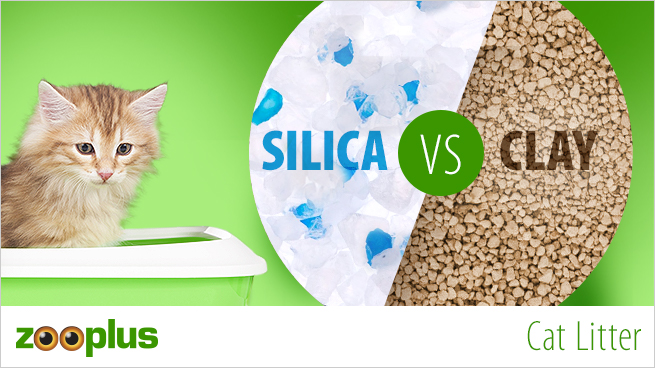Silica cat litter and clumping natural clay litter are the most popular choices among cat owners and their cats. But which litter is better for the cat, the owner or the environment?
The Components
Clumping litter is made from clay materials, such as bentonite. Clay is naturally porous and absorbs excessive amounts of moisture. The clay granules soften when they absorb liquid and stick together forming clumps, which cat owners can easily remove from the litter tray. How stable these clumps are and how easily they can be removed all depends on the manufacturer.
Silica litter or crystal litter consists of quartz sand and has a unique structure to its atoms. This helps the silicon bind with a high amount of liquid and neutralise any odours.
Capacity
In the case of clumping litter, only formed clumps are removed from a litter box. Clumping litter is therefore very good value because any unused litter is still useable and you only need to top up your cat’s litter box when needed.
Silica litter, on the other hand, will absorb moisture until it reaches its capacity. This means that silica litter can last for up to four weeks before it needs to be changed. It works differently to clumping litter, but at the same time is also very economical as 5 litres of silica litter equates to roughly three times the amount of clumping litter.
Weight
Bags of cat litter a quite heavy and can weigh several kilos. Clumping litter is among one of the heaviest, as clay is a relatively heavy material.An advantage of silica litter is that it is not as heavy as clumping litter. The weight of silica litter increases as it absorbs liquid.
Hygiene
Cats are clean animals and very sensitive to odours. Therefore, the ideal litter should not only absorb moisture, but also neutralise odours.Clumping litter made with natural materials absorb moisture and form clumps which can be removed from the litter tray.
Silica litter absorbs moisture and binds odours with its unique structure. Instead of removing clumps, silica litter needs to be changed. It can remain in your cat’s litter tray for up to four weeks without giving off the characteristic smell of cat urine. However, this type of litter isn’t for everyone. Both options are hygienic, but which one you choose is all a matter of preference.
Environment
The natural clay materials in clumping litter are biodegradable and environmentally friendly. However, many silicate-based litters are now designed to be compostable too.
Health
One of the main advantages of silica litter over traditional clumping litter is that it is almost entirely dust free, which makes it particularly preferable in households with allergies.
Clumping litters often has other organic material such as quartz, calcite and mica added to it. However, in 2000, a study found that 2 out of 20 tests on cat litter products tested positive for respirable carcinogens. Whilst many cat litters are now branded as “arsenic-free”, it is important to note that the term “free” here means “below the limit of detection”.
The Agony of Choice
Finding the perfect litter box for your cat is not easy, especially when considering yours and your cat’s preferences: Do you prefer clumping cat litter with a lovely baby powder scent, but your cat isn’t as keen? Or maybe your cat’s paws are too delicate for hard silica crystals? Maybe you are happy with your current litter. Or could you be both dissatisfied and looking for something new?
It’s important to note that cats are creatures of habit. So, if your cat refuses to use its new litter just give it time. As with changing your cat’s food, mix the new variety in with the old stuff to help your cat get used to its new litter.
